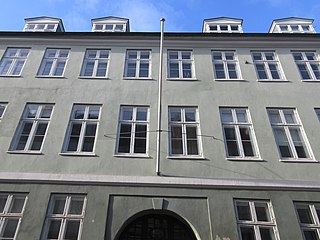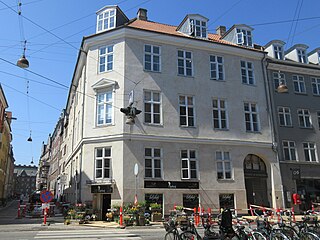
Ploug House is a listed Neoclassical property on the corner of Højbro Plads and Ved Stranden in central Copenhagen, Denmark. It dates from the building boom which followed after the Copenhagen Fire of 1795 but takes its name from the poet, publisher and politician Carl Ploug who lived there in the 1860s and 1870s and also published the newspaper Fædrelandet from the premises.

The Jennow House is a historic property located at Strandgade 12 in the Christianshavn neighbourhood of Copenhagen, Denmark. It takes its current name after Andreas Jennow, a businessman who owned it from 1949 to 1978. His company Andreas Jennow A/S was based in the building until 1988.

The Jens Lauritzen House is a Neoclassical property at Nytorv 7 in the Old Town of Copenhagen, Denmark. Home to the Association of Folk High Schools in Denmark, the building is now also known as Højskolernes Hus.

Nyhavn 11 is an 18th-century property overlooking the Nyhavn canal in central Copenhagen, Denmark. Ludvig Ferdinand Rømer established a sugar refinery on the property in 1653 and it was later continued by changing owners until at least the 1860s. A small figure of a sugar-baker holding a sugar cone is still seen above the gate. The building was listed in the Danish registry of protected buildings and places in 1932. Notable former residents include the general trader Jacob Severin and actors Christian Niemann Rosenkilde, Julie Sødring and Poul Reumert. The lamp manufacturer Louis Poulsen was later based in the building from 1908 to 2006.

The Verrayon House is a Rococo, bourgeoisie townhouse located at Lille Strandstræde 6 in central Copenhagen, Denmark. It was listed by the Danish Heritage Agency in the Danish national registry of protected buildings in 1943.

Badstuestræde 18 is a Neoclassical property in Badstuestræde in the Old Town of Copenhagen, Denmark, constructed for brewer Peter Møller as part of the rebuilding of the city following the Copenhagen Fire of 1795. It was listed in the Danish registry of protected buildings and places in 1918. Notable former residents include the philologist Jacob Baden, actor Peter Jørgen Frydendahl, ballet master Carl Dahlén, actress and opera singer Johanna Elisabeth Dahlén and later ballet master of the Royal Swedish Ballet, Sigurd Harald Lund.

Nyhavn 19 is a property located at the corner of Nyhavn and Lille Strandstræde in central Copenhagen, Denmark. The building was listed on the Danish registry of protected buildings and places.

Gammel Strand 38 is a Neoclassical property overlooking Slotsholmen Canal in the Olt Town of Copenhagen, Denmark. The building was listed in the Danish registry of protected buildings and places in 1945.

Gammel Strand 40 is a Neoclassical property overlooking Slotsholmen Canal in the Olt Town of Copenhagen, Denmark. The building was listed in the Danish registry of protected buildings and places in 1945. A commemorative plaque above the doorway commemorates that Georg Carstensen, founder of Tivoli Gardens, was a resident in the building when his amusement park opened in 1843.

Badstuestræde 7 is a Neoclassical property situated off the shopping street Strøget in the Old Town of Copenhagen, Denmark. The building was like most of the other buildings in the street constructed in the years after the Copenhagen Fire of 1795. It was listed in the Danish registry of protected buildings and places in 1964.

Brolæggerstræde 6 is a Neoclassical property situated in the Old Town of Copenhagen, Denmark. It was listed in the Danish registry of protected buildings and places in 1950. Former residents include the later bishop Jacob Peter Mynster and the politician Balthazar Christensen.

Kompagnistræde 12 is a Neoclassical property situated on the shopping street Strædet, between Badstuestræde and Knabrostræde, in the Old Town of Copenhagen, Denmark. Like most of the other buildings in the area, it was constructed as part of the rebuilding of the city following the Copenhagen Fire of 1795. The building was listed in the Danish registry of protected buildings and places in 1964. C. E. Fritzsche, a glass shop with roots dating back to 1788, is now based in the building.

Kompagnistræde 32 is a Neoclassical property situated on Kompagnistræde, between Rådhusstræde and Hestemøllestræde, in the Old Town of Copenhagen, Denmark. Built with three storeys over a walk-out basement by Andreas Hallander in 1799, it was later expanded by one storey in the 1840s. A brewery was operated in a rear wing from its construction until at least the 1860s. The building was listed in the Danish registry of protected buildings and places in 1968. An adjacent warehouse and the rear wings are not part of the heritage listing. The Danish Union of Teachers was headquartered in the building from 1957. The union is now based at nearby Vandkunsten 12 but their old headquarters is still owned by them and let out as office space.

Rådhusstræde 6 is a Neoclassical property situated at the corner of Rådhusstræde and Kompagnistræde, betweenGammeltorv-Nytorv and Gammel Strand, in the Old Town of Copenhagen, Denmark. It was constructed by Andreas Hallander, one of the most active master builders in the rebuilding of the city following the Copenhagen Fire of 1795.The building was listed in the Danish registry of protected buildings and places in 1964. Notable former residents include the politicians Johan Nicolai Madvig and J.A. Hansen. Later acquired by the Danish Union of Teachers, it housed the Danish School Museum from 1995 to 2008.

Naboløs 1 is a Neoclassical property situated at the corner of the streets Neboløs and Læderstrlde, close to Gammel Strand, in the Old Town of Copenhagen, Denmark. Together with the adjacent buildings at Naboløs 3 and Gammel Strand 52, it was constructed by Hans Christian Ondrup as part of the rebuilding of the city following the Copenhagen Fire of 1795. It was listed in the Danish registry of protected buildings and places in 1945.

Amagertorv 1 is a Neoclassical property situated at the corner of Amagertorv and Højbro Plads, opposite Højbrohus, in the Old Town of Copenhagen, Denmark. Constructed in 1797 as part of the rebuilding of the city following the Copenhagen Fire of 1795, it owes its current appearance to a renovation undertaken by Christian Tybjerg in 1854. The building was listed in the Danish registry of protected buildings and places in 1989. Café Europa, a café started by fashion designer Jørgen Nørgaard in 1989, is located in the building. Notable former residents include photographer Emil Stæhr, landowner and district governor Nicolai Emanuel de Thygeson and composer and music publisher Andreas Peter Berggreen.

Læderstræde 5 is a Neoclassical property situated on Strædet, close to Højbro Plads, in the Old Town of Copenhagen, Denmark. A private sunagogue was from 1800 to 1836 and again from 1845 to 1986 based on the first floor of the building. The second synagogue was opened by Moses Levy and was for many years the only alternative to the Great Synagogue in Krystalgade. In his will, Levy converted the building into a foundation under the name Moses Levt's Stiftelse og Synagoge. The building was listed in the Danish registry of protected buildings and places in 1945. The publishing house Tiderne Skifter is now based on the first floor.

The Journalists' House, situated at Gammel Strand 46, opposite Thorvaldsens Museum and Christiansborg Chapel, is the Danish Union of Journalists' headquarters in Copenhagen, Denmark. The Neoclassical building was constructed by Andreas Hallander as part of the rebuilding of the city following the Copenhagen Fire of 1795, incorporating elements from the previous building on the site.It was listed in the Danish registry of protected buildings and places in 1918. Notable former residents include the clergy Christian Bastholm, poet and translator Ditlevine Feddersen, agriculturalist Oluf Christian Olufsen, naval officers Peder Norden Sølling and Carl Irminger, opera director and choir conductor Giuseppe Siboni, court physician Joachim Lund Drejer, ballet master August Bournonville, schoolmistress Natalie Zahle and church historian Carl Joakim Brandt.

Pilestræde 37/Konnprinsensgade 13 is an 18th-century building situated at the acute-angled corner of Pilestræde and Kronprinsensgade in the Old Town of Copenhagen, Denmark. It was listed in the Danish registry of protected buildings and places in 1945. It was constructed by the master mason and developer Johan Peter Boye Junge, who has also constructed the buildings at Pilestræde 39-47 in conjunction with his creation of the street Kronprinsensgade, and who was himself a resident of the building from its completion in 1786. Other notable former residents include actors Michael and Johanne Rosing, printmaker Andreas Flinch, poet Christian Winther and Bing & Grøndahl co-founder Meyer Herman Bing.

Kompagnistræde 20 is a Neoclassical building complex situated at the corner of Kompagnistræde and Knabrostræde in the Old Town of Copenhagen, Denmark, constructed in 1796–97 as part of the rebuilding of the city following the Copenhagen Fire of 1795. A brewery was for more than 200 years, from at least the late 1640s until the 1860s, operated on the site. The building complex comprises a residential corner building as well as an adjacent warehouse at Knabrostræde 16 and another warehouse in the courtyard. The entire complex was listed in the Danish registry of protected buildings and places in 1945. Notable former residents include the government official Jacob Gudel, civil servant and later Minister of Interior Affairs I.J. Unsgaard and painter and photographer Edvard Valdemar Harboe.
























